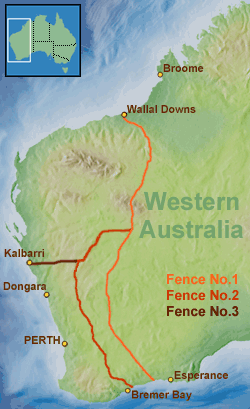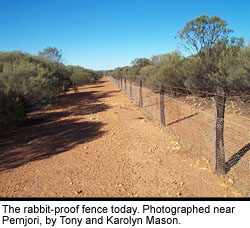|
 In
1896, Arthur Gregory Mason reported that rabbits were at least two hundred
miles past the South Australian border and inside Western Australia at
the town of Eucla. His recommendation to the government was to build a
rabbit proof fence. In
1896, Arthur Gregory Mason reported that rabbits were at least two hundred
miles past the South Australian border and inside Western Australia at
the town of Eucla. His recommendation to the government was to build a
rabbit proof fence.
After much debate and a Royal Commission, the government
eventually adopted the idea of a barrier fence. In 1901 the Government
Surveyor, AW Canning surveyed a route for the fence and its construction
began in December the same year.
Seven years of hard work followed - gangs of men, teams
of horses, mules, camels, wagons, carts, picks and shovels, and a lot
of sweat and tired muscles. When the fence was completed it was the longest
fence in the world, stretching from Starvation Boat Harbour, just west
of Esperance in the south, to Wallal on the 80 Mile Beach in the north
west.
 Even before completion, the rabbits were past the fence and work had begun
on Fences No.2 and 3. By 1908 the three fences were complete, over 3,000km
of fenceline in total!
Even before completion, the rabbits were past the fence and work had begun
on Fences No.2 and 3. By 1908 the three fences were complete, over 3,000km
of fenceline in total!
Although the construction of the fences was finished,
someone was needed to patrol and maintain them. Alex Crawford was appointed
the first Chief Inspector of Rabbits and was required to inspect and maintain
the fences. Everything inside the fence became known, jokingly, as Crawford's
Paddock. Inspecting the fence was an immense task. Crawford had many work
parties to assist him, but the country was rough and in many areas water
was scarce or non-existent.
Without water, the use of horses to carry out the fence
inspection was difficult. When camels were used, it was found that inspection
of the fence was unsatisfactory from atop a beast, so bicycles were given
a go - a short lived experiment due to the rough conditions and many flat
tyres!
In
1910, a motor vehicle was purchased to carry out the inspection, but was
also to prove unsatisfactory. After
many punctures and broken springs it had to be towed slowly back to camp
by camels! In the end the only workable solution for the inspection teams
were buckboard buggies pulled by pairs of camels.
Despite the best efforts to stop the rabbits at the barrier fence, all
was to fail. Erosion under the fences, holes in the wire and gates left
open allowed rabbits to continue their movement west into the fertile
agricultural areas. Ten rabbits could eat as much as one sheep. In their
hundreds of thousands they ate out pasture, ring-barked trees and devoured
crops.
|

 In
1896, Arthur Gregory Mason reported that rabbits were at least two hundred
miles past the South Australian border and inside Western Australia at
the town of Eucla. His recommendation to the government was to build a
rabbit proof fence.
In
1896, Arthur Gregory Mason reported that rabbits were at least two hundred
miles past the South Australian border and inside Western Australia at
the town of Eucla. His recommendation to the government was to build a
rabbit proof fence.  Even before completion, the rabbits were past the fence and work had begun
on Fences No.2 and 3. By 1908 the three fences were complete, over 3,000km
of fenceline in total!
Even before completion, the rabbits were past the fence and work had begun
on Fences No.2 and 3. By 1908 the three fences were complete, over 3,000km
of fenceline in total!